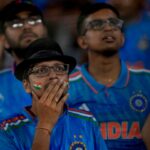Energy News Beat
Mumbai, India – A deafening silence and rows of empty seats: the Cricket World Cup 2023 ended the same way it had started.
The Narendra Modi Stadium in India’s western state of Gujarat saw an exodus of fans long before Australia hit the winning runs in Sunday’s final.
list of 4 items
list 1 of 4
Calm Australia beat favourites India for sixth Cricket World Cup crown
list 2 of 4
Australia use conditions and the toss to win World Cup, Indian legends say
list 3 of 4
Dravid urges heartbroken India players to ‘move on’ after World Cup loss
list 4 of 4
Photos: Head breaks India hearts as Australia win sixth World Cup title
end of list
The Aussies are now six-time winners of the title. For hosts India, who reached the final after 10 unbeaten matches, a dream died.
“I was quite excited about the match as it was my first time watching India at the World Cup, but it just wasn’t our day,” Sriraj Namboodiri told Al Jazeera from Ahmedabad over telephone.
Australian players celebrate with the ICC Men’s Cricket World Cup trophy in Ahmedabad [Rafiq Maqbool/AP]
The much-anticipated final had been a topic of discussion across the cricket-obsessed South Asian nation, where people thronged restaurants, pubs and cafes for public screenings of the India-Australia clash.
But as the Indian players stumbled and stared at defeat, thousands of fans in the 100,000-plus-capacity stadium began to leave their seats before the game ended – a sorry image after India’s flawless route to the final.
“The crowd at the stadium was really bad. I didn’t enjoy the experience,” said Namboodiri, who had come to watch the game with his brother from Mumbai.
“Had the match been in Chennai or Mumbai, most fans would have stayed back until the end for the presentation ceremony. After all, this was a World Cup final, the biggest match in world cricket and it was happening on our home soil.
“As a cricket fan, you would stay. If you’re leaving, it’s only because you are a fake fan.”
Annujj Palaye, a communications professional for a top-tier Indian football team, said seeing Indian fans leave early was “understandable”, but he said he was more disappointed by the crowd’s failure to cheer India during their tough moments.
“It’s a beautiful stadium and makes for a great setting, which is probably why it was chosen for the final. But it didn’t seem like India had a home advantage,” Palaye said.
“The crowd was pumped up in the first 10 overs of both the innings, but for the largest part, it was mostly silent.”
Toss plays huge role
Namboodiri said losing the toss itself was a turning point for the host team.
“It was a black soil pitch, which is considerably tougher to bat on. The pitch was kind of sluggish and pacer friendly,” explained Namboodiri, a sports media professional himself.
“As per India’s current batting strategy, Rohit [Sharma, Indian captain] usually gives the team a firing start and Shubman Gill or Virat Kohli build on it. Rohit did his job but Gill got out soon, so that put pressure on Kohli and KL Rahul to get a steady start. Kohli was unlucky to get out and, after that, the team lost its anchor in the middle order,” he added.
According to Radha Lath Gupta, a management student in Ahmedabad who attended the finals, India fell short of 30 to 40 runs in their target.
“The first 10 overs of India’s bowling were so electric, but the bowling change later got a bit predictable. Since we had fewer runs on the board, Australia could just rotate the strike and make do. They didn’t have to play risky shots,” she said.
“India didn’t put any pressure while fielding, either. Spinners Ravindra Jadeja and Kuldeep Yadav, on either end, gave [Travis] Head and Marnus Labuschagne time to settle down. Once a top-quality batter settles in a World Cup final, it’s quite hard to get them out.”
Indian players waiting for the award ceremony to begin after losing to Australia [Rafiq Maqbool/AP]
During a post-match interview, former West Indies player and cricket commentator Ian Bishop praised Australia, saying India lost to a team that has a “championship-winning DNA”.
Gupta agreed. “Australia had a proper World Cup run. They had challenges at the start, which prepared them for the end. Australia didn’t have a perfect tournament but they had a run which peaked at the right time,” she said.
Sunday’s final was a repeat of the 2003 World Cup, when Australia beat India by 125 runs in the final after the then-Australian captain Ricky Ponting’s 140 runs helped the team post an impressive score of 360.
Palaye, who had watched the 2003 final on TV, said the game was similar to this year’s summit clash.
“At that time, India were dominating opponents and a new age of cricket had started under Sourav Ganguly, an aggressive [former] Indian captain. That was the new face of Indian cricket,” he said.
“Conceding 350-plus runs after the performance India had in the [2003] tournament was like a punch in the guts. It was similar to this year’s final.”
What next for Sharma and Kohli?
Indian captain Rohit Sharma, 36, and the ace hitter Virat Kohli, 35, looked teary-eyed as their excellent campaign ended on a dull note – Kohli, player of the tournament, scored a record 765 runs with an average of 96 runs, while Sharma was the second-highest with 597 runs.
“At this World Cup, you got to see a different Rohit with his fearless captaincy, somebody who did not want to play pragmatically. That sums him up perfectly,” Palaye told Al Jazeera.
“I know that Rohit may not get a chance to play at the World Cup again, but it won’t be a blemish on his career.”
While India’s fans expect Sharma to play the 2027 edition of the tournament, they also hope to see the athletic Kohli play until then.
“Fitness-wise, Kohli can play in 2027, but it depends on him. We can’t really say for sure what’s going on in his mind,” Namboodiri said.
Gupta, on the other hand, is not sure.
“It is unlikely that a 39-year-old would play at a World Cup, but if there is anyone who could play at 39, it would be Kohli,” she said.
India coach Rahul Dravid, right, and former captain Virat Kohli [File: Adnan Abidi/Reuters]
Aussies face online abuse
Soon after Australia’s players were covered in confetti as they celebrated their sixth World Cup triumph, some of them faced abuse on social media.
Head, whose superb 137 ensured his team’s victory, was one of the prime targets of the online harassment and threats on Instagram, with some accounts even issuing rape threats directed towards his wife.
Australian sports presenter and podcaster Ian Higgins also received abusive messages. New Zealand’s player Jimmy Neesham shared screenshots of the abuse he received from Indian fans, who mistook him for an Australian player.
Palaye condemned the fans’ behaviour.
“I understand that sports tend to make people emotional, but you need to have a rational mind to know where to divert that anger,” he said.
“I don’t know where such hatred even comes from, but those fans need to do better to use that energy. Australia were the better team from the toss to the final ball – you just have to admit it.”
The Narendra Modi Stadium in Ahmedabad saw an exodus of Indian cricket fans long before Australia hit the winning runs.
ENB Top News
ENB
Energy Dashboard
ENB Podcast
ENB Substack
The post Fans slam ‘mostly silent’ crowd at India-Australia World Cup title clash appeared first on Energy News Beat.








